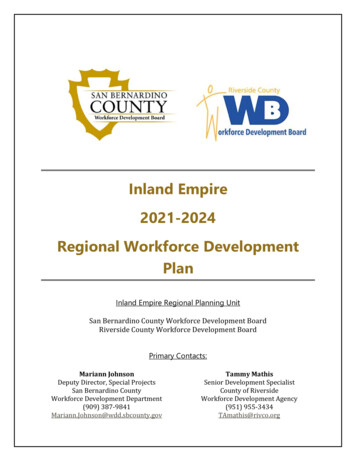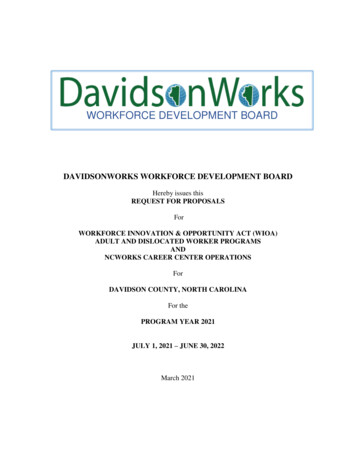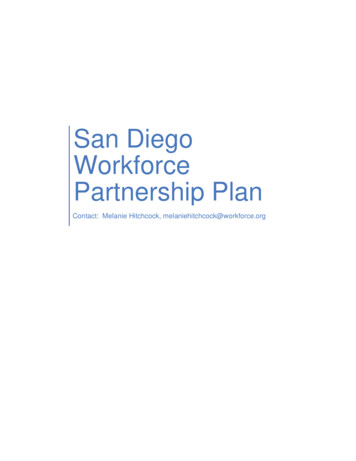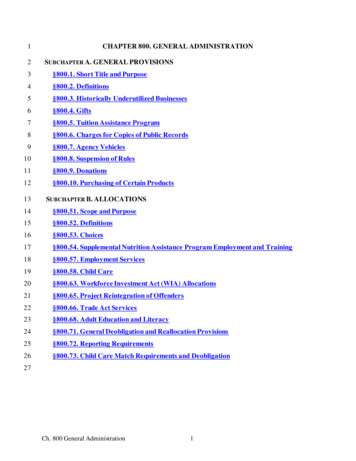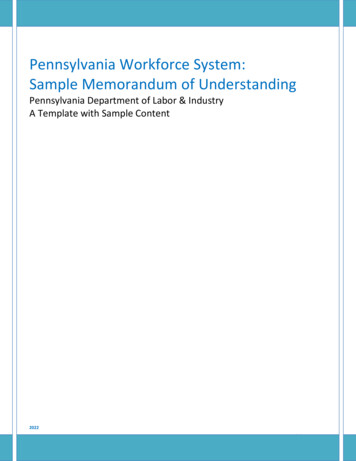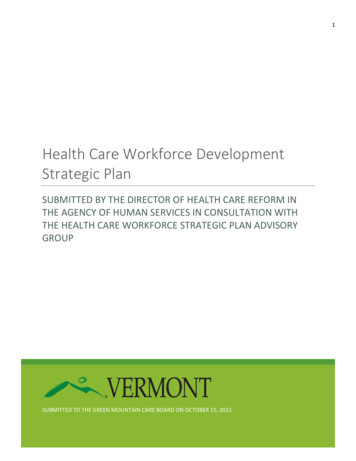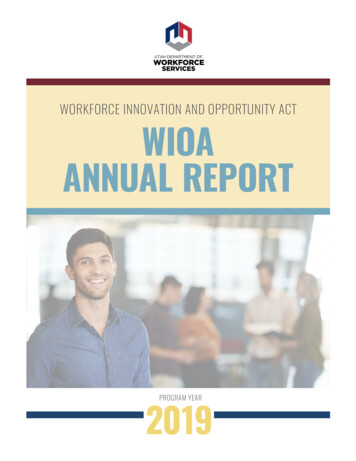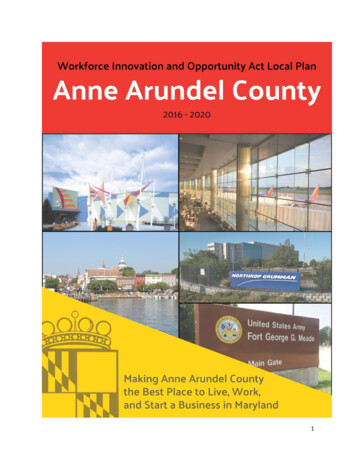
Transcription
1
The Local Workforce Development Board for Anne Arundel County, Maryland certifies that itcomplies with all required components and assurances of the Workforce Innovation andOpportunity Act plan development guidelines issued by the State of Maryland. The Local Boardalso assures that funds will be spent in accordance with the Workforce Innovation andOpportunity Act, Wagner Peyser Act, and their regulations, written U.S. Department of Laborguidance implementing these laws, Office of Management and Budget circulars, and all otherapplicable federal and state laws, regulations, and policies.Local Chief Elected OfficialDateDate2
ContentsGlossary4Introduction5Executive Summary6Section 1: Strategic Planning11Section 2: Alignment of the Local Workforce Development System21Section 3: American Job Center Delivery System32Section 4: Title I – Adult, Youth and Dislocated Worker Functions43Section 5: Wagner-Peyser Functions51Section 6: Title II – Adult Education and Family Literacy Functions53Section 7: Vocational Rehabilitation Functions56Section 8: Temporary Assistance for Needy Families Functions58Section 9: Jobs for Veterans State Grants Functions60Section 10: Fiscal, Performance and Other Functions62Attachment 1 – Anne Arundel County Local Workforce Development Board Member List75Attachment 2 – Policy Development Schedule77Attachment 3 – Conflict of Interest Policy for Board Members78Attachment 4 – Anne Arundel Customer Centric Design802016-2020 Local Plan Assurances813
GlossaryAACC – Anne Arundel Community CollegeAACCC – Anne Arundel County Career Center, a proud partner of the American Job Center networkAACPS – Anne Arundel County Public SchoolsAAEDC – Anne Arundel Economic Development CorporationAALWDB – Anne Arundel County Local Workforce Development BoardAACPL – Anne Arundel County Public LibraryAACCAA – Anne Arundel County Community Action AgencyAAWDC – Anne Arundel Workforce Development CorporationABE – Adult Basic EducationAD – Adult Workers, anyone who is looking for training or employmentAJC – American Job CenterCASAS – Comprehensive Adult Student Assessment SystemsCBO – Community-based organizationClient individual seeking training and/or employmentCP – Career pathwaysCSBG – Community Service Block GrantCustomer BusinessDLLR – Maryland Department of Labor, Licensing & RegulationsDOL – U.S. Department of LaborDORS – Division of Rehabilitation ServicesDSS – Department of Social ServicesDW – Dislocated Worker, someone who lost a job to no fault to their ownEARN Maryland – Employment Advancement Right Now MarylandFBO – Faith-based organizationGED – General Educational Development (High School Diploma)GWDB – Governor's Workforce Development BoardHITCH – Hospitality, IT, Transportation, Construction, Healthcare industriesITA – Individual Training AccountJWA – JobsWork!. Arundel, AAWDC’s job readiness initiative with DSSLMI – Labor Market InformationLWDB – Local Workforce Development BoardMHEC – Maryland Higher Education CommissionMOU – Memorandum of UnderstandingMWE – Maryland Workforce ExchangeNEDP – National External Diploma ProgramRFP – Request for ProposalsRR-Rapid ResponseRSA – Resource Sharing AgreementSNAP – Supplemental Nutrition Assistance ProgramTABE – Test of Adult Basic EducationTANF – Temporary Assistance for Needy FamiliesUI – Unemployment InsuranceWagner-Peyser – The 1933 law that created & funds the employment services officesWIOA – Workforce Innovation and Opportunity Act4
IntroductionThe Workforce Innovation and Opportunity Act (WIOA) was signed into law on July 22, 2014, and wentinto effect July 1, 2015. WIOA supersedes the Workforce Investment Act of 1998, and amends the AdultEducation and Family Literacy Act, the Wagner-Peyser Act, and the Rehabilitation Act of 1973. WIOA isdesigned to help both job seekers and businesses. WIOA addresses the needs of jobseekers throughestablishing a workforce system that helps them access education, training, and supportive services togain employment and succeed in the labor market. WIOA also addresses business needs by matchingthem to the skilled workers they need to compete in the global economy.In order to ensure Maryland’s effective implementation of the requirements of the new federal law, theWIOA partners agreed on the development and implementation of proven best practices and strategiestowards system improvement. Anne Arundel County developed its own Local Workforce DevelopmentPlan that outlines the vision, objectives, and strategies for WIOA implementation in the Local Area.This Plan is in line with the Maryland’s Combined State Workforce Plan, which has a vision of aMaryland where every person maximizes his or her career potential and businesses have access to thehuman resources they need to be successful.The implementation of the Plan will also be governed by the principals outlined by County ExecutiveSchuh as he strives to make Anne Arundel County the best place in Maryland.Workforce development fits into the County Executive’s vision as follows: Best place to live – People want to live in an area that is growing and thriving, and an area wherethey can easily access employment. With excellent workforce development programs in the area thatallows residents to get the skills and certifications needed they can become more employable. Withprosperous businesses there are increased employment opportunities in the region. Best place to work – People want to work in a steady, well-paying job for a business that isflourishing and not at risk of moving or closing. When businesses can thrive in the County, there areincreased job opportunities, increased opportunities for incumbent workers to move up the career ladder,and increased salaries from booming businesses looking for top talent. Best place to start a business – Businesses need a skilled workforce in order to thrive, grow, andsucceed in the economy. When the County can provide the skilled workforce businesses need, thebusinesses are more successful allowing them to grow and expand within the area. Also, when the Countyproves that they have the workforce businesses need and that the region allows businesses to thrive theCounty become more appealing for businesses to move to.5
Executive SummaryAnne Arundel County, Maryland is located in the Baltimore Region—consisting of Baltimore City, AnneArundel, Baltimore, Carroll, Cecil, Harford, and Howard Counties. It is also adjacent to the WashingtonMetropolitan region that includes Montgomery and Prince George’s Counties. Both regions have a heavyconcentration of government and government contractor jobs and Anne Arundel includes a large numberof healthcare and professional & scientific services jobs. These industries provide over 1.2 million jobsand will create the largest demand for workers within the next 4 years. In total, the projected job demandin the top 10 largest industries in the region is about 40,000 jobs 1. In addition, demand in theclassifications of arts and entertainment, management of companies, and transportation and warehousingis projected to grow in the very near future. Anne Arundel County includes rural, urban, and industrialareas providing opportunities for both Anne Arundel County businesses and individuals to grow andprosper but requiring government and workforce professionals to be innovative and thoughtful whendeveloping service delivery programs.The largest single concentration of jobs in the County is at and around Fort George G. Meade includingthe National Security Agency, the Defense Information Systems Agency, and the contractors that supporttheir mission. Other significant employment hubs in the County include: The North County Industrialzone, the BWI Airport zone, the Arundel Mills zone, two regional hospitals, and the City of Annapolis.An estimated 159,000 jobs are located within these zones 2.The Anne Arundel County Local Workforce Development Board (the Board) has decided to focus on thehigh growth industries of Hospitality, Information Technology, Transportation, Construction, andHealthcare (“HITCH”). These industries are projected to grow and create the greatest occupationaldemand in the Region:Focus IndustryHospitalitySubindustriesAccommodation and FoodServices, Retail and TechnologyTransportationTransportation, Warehousing andLogisticsConstructionConstruction and ManufacturingHealthcareHealthcare and Social ServicesIn Demand Certifications 3Automotive Service Excellence (ASE),Servsafe, Casino Gaming License,Registered Dietitian, Certified PharmacyTechnician, Bartender certificationsSecurity Clearance, ProjectManagement, CISSP, CISCO, Security , IT Infrastructure Library, Network CDL Class A, Environmental ProtectionAgency Certification, SecurityClearanceSecurity Clearance, CISSP,SANS/GIAC, Project Management,Security , Network , OSHARegistered Nurse, First Aid CPR, BasicCardiac Life Support, Certified NursingAssistant, Nurse Practitioner, Caregiver,PhlebotomyEven though the median household income in Anne Arundel County is very strong (over 94,000) and thepoverty rate is low (3.9%), there are populations that have substantial barriers to employment and lack a1EMSIAnne Arundel Economic Development Corporation3Burning Glass26
sustainable income. Among those groups are veterans, individuals with disabilities, out-of-school youth,long-term unemployed, low-skilled individuals, ex-offenders, and people receiving governmentassistance.County ResidentsPopulation who don’t have a High School DiplomaHave a High School DiplomaHigher than HSD but no BS degreeBachelor’s degree or higherVeteransIndividuals with disabilitiesOut-of-school youth ages 18-24Long-term unemployed (those who exhausted their UI benefits)Ex-offenders (parole and probation supervision)Older workers (50 )Working poorTANF recipientsSNAP 2% of population of 18 years or older10.6%24,000 (47%)Over 3,0003,50034.4%3,241 people below poverty level areunemployed5,70040,000335Source: 2017 ACS, DLLR, DSS.To serve these segments of the population and make employment services beneficial to all Countyresidents, the Anne Arundel County Workforce System takes a demand-driven approach that includes thefollowing elements: Engaging Businesses: collaboration with businesses to determine local and regional hiring needs,design innovative initiatives and trainings that are responsive to those needs, and get candidateson a career path.Work and Learn Training: working with businesses to offer a variety of hands-on, work-basedlearning opportunities that create a pipeline of candidates with the experience and skillsbusinesses require.Smart Choices: analysis of local and regional labor market data to drive in-demand services tobusinesses and candidates.Measuring Matters: continuous evaluation of trainings, employment, and earnings outcomes toensure excellent services and positive economic impact.Career Progressions: collaboration with businesses and partners to design and deliver pathwaysthat prepare candidates to reach their full career potential.Opening Doors: determination and addressing systemic barriers to employment.Regional Partnerships: leading in bring together partners to develop a strong regional economy.The Board, whose members are appointed by the County Executive, drives and informs the developmentof the priorities and strategies of the system. The role of the Board is to align the workforce development7
system and make sure the partnersare working together to meet theneeds of customers and clients,where businesses are customersand represent demand and clientsare individuals and representsupply.At the same time, the main goal ofthe Board is to narrow the gapbetween the supply of workers(individual clients) and businessdemand (business customers) byproviding innovative workforcesolutions. As a result, businesseswill have a pipeline of skilled workers and individuals will have the skills to reach their full careerpotential.The Board is representative of all the mandatory and non-mandatory partners and the membershipincludes representatives of growth industries in the county. The Board has set up four committees thatwork on specific topics and strategies. This structure allows the Board to be an effective convener ofbusinesses, mandatory and non-mandatory partners, and the community with the objective of developinga strong and efficient workforce development system in the County.Board committees are engaged in the oversight of the development of strategies and the performance ofthe WIOA partners. In particular, the committees oversee the performance and activities of the CareerCenters, WIOA funding allocations, and policy development.The Board developed a number of priorities that will govern and drive the Board’s activities in the area.These priorities are: Providing oversight of the County’s workforce funds to ensure wise usage leading to a greaterreturn on investmentGuiding business and industry solutions so County businesses remain competitive by hiring andretaining the talent essential to meet their current and future workforce needsProviding insights into the labor market that help County residents meet their full career potentialby having the skills and credentials that meet the needs of local and regional businessesEnsuring that Anne Arundel County’s most vulnerable residents receive the services they need tostart on a career pathway that leads to self-sufficiencyEngineering innovative solutions to address and mitigate the barriers to employment of CountyresidentsOverseeing the Anne Arundel County Career Center operations to ensure all visitors receiveexcellent customer serviceDeveloping demand-driven workforce development strategies, making Anne Arundel County aleader in demand-driven implementationCultivating the Anne Arundel County workforce development system so that it leads to a positiveeconomic impact on the local and regional economy, making Anne Arundel County the bestplace in Maryland8
In order for the system to be efficient and ensure that the demand has been met, the Board continuesworking in close collaboration with system partners. The Anne Arundel County Workforce Developmentsystem consists of the following partners (*Career Center required partners):System Partners (Section 121 (1)(B) of WIOA)PartnerAnne Arundel Workforce DevelopmentCorporation*Division of Labor and Industry of the MarylandDepartment of Labor, Licensing and Regulation*RoleAdult, Dislocated Workers, Youth servicesWagner-Peyser, Trade-Adjustment Assistance,Jobs for Veterans State Grants, UnemploymentInsuranceDivision of Rehabilitation Service*The Vocational Rehabilitation programSenior Services of America, Inc.The Senior Community Service EmploymentProgramAnne Arundel County Public SchoolsK-12, Technical education at the secondary levelAnne Arundel Community CollegeAdult Education and Literacy activities; trainingprovider; Career and technical educationprograms at the post-secondary levelJobCorpsJob readiness services for youthAnne Arundel County Community Action Agency Community Block grant administrator andsupportive services providerThe Housing Commission of Anne ArundelEmployment and Training activitiesCountyAnne Arundel County Department of SocialTANF and SNAPServicesLocal Management BoardOutreach and supportive servicesCommunity-based organizationsOutreach and supportive servicesFaith-based organizationsOutreach and supportive servicesAnne Arundel Economic DevelopmentBusiness EngagementCorporationAnne Arundel County Public LibrariesOutreach and Service Delivery* denotes Career Center required partnersAdult Basic Education is collocated with the other core partners at the new Career Center. In addition, theBoard designates the Anne Arundel County Department of Social Services as an affiliate Career Center tooffer services for clients receiving public assistance, (i.e. Temporary Assistance for Needy Families(TANF), Supplemental Nutrition Assistance Program (SNAP), and foster care youth).The Board recognizes that the role of economic development is to create and retain jobs in the County,and the workforce development’s role is to develop the talent to fill these jobs.To ensure a highly effective service delivery system in the County, the Board created an AlignmentCommittee that includes representatives of all the system partners. The Anne Arundel AlignmentCommittee established a Career Center workgroup that will focus on integration and continuousimprovement of Career Center services.Under the demand-driven model, understanding the needs of businesses is a prerequisite for developingeffective strategies. The Board will continue to utilize labor market research and analysis as well asinformation gathered by engaging businesses to learn about the workforce needs and trends. This willensure that the service delivery system fully understands and meets the needs of customers. In addition,9
since some workforce challenges are significant enough to impact an entire industry, the Board willcontinue addressing them by creation of industry sector partnerships, i.e. bringing together businesses,economic development, workforce development, education and training, government, labor, andcommunity organizations focused on a particular industry within a local or regional labor market.The Anne Arundel County Business Services Team is comprised of the Business Solutions Team ofAAWDC and Business Service representatives from DORS, DLLR (including LVERs), AAEDC, andAACC. The Business Team conducts an array of services for businesses such as consultative business callprograms, sourcing and recruitment strategies, talent management and development, incumbent workertraining, and connection to other services to ensure Anne Arundel County businesses have the resourcesto continue to grow and thrive.The Board will utilize a client-centric approach in providing services to job seekers/clients. The approachinvolves the extension of time individuals are engaged in the workforce development system andencourages the partners to develop innovative services to meet clients where they are to start, advance or,transition in a career path, address their barriers to employment, and ensure that they have essentialworkplace skills and industry certifications in order to meet their full career potential.The Board wants to make sure that there are different training models that ensure the system meets theneeds of businesses. The Board recommends a variety of approaches to skills enhancement to include butnot limited to short-term occupational training, work and learn models (including apprenticeships),incumbent worker training, essential workplace skills training, and contextualized trainings.The Board also recognizes the need to prepare an emerging workforce for starting on a career path andacquire necessary education, skills, credentials, and experience. To facilitate the process and help youth tofind their career, the Board will support a model that includes career exploration, essential skills training,occupational trainings that lead to credentials, and work experience opportunities.In order to support the challenges that clients face in obtaining employment and training, the Board willensure strong collaboration and alignment of supportive and wraparound services with partners withexpertise in providing these services.Whereas the Board agrees with the State’s vision for putting people before performance, the Board willmake certain that continuous improvement and analysis of performance is a priority for all programs.Development of initiatives and programs will be based on industry demand. Program activities andoutcomes will be tracked and analyzed to uncover trends and evaluate efficiency and effectiveness ofstrategies. The Alignment Committee and the entire Board will review performance and labor marketreports on a regular basis and will provide recommendations as to adjustments and improvements.Through the development of the Local Plan, the Board strives to be an innovative leader in workforcedevelopment by utilizing labor market information to drive decisions and continuous improvement thatleads to a positive economic impact on the local and regional economy.10
Section 1: Economic AnalysisA. An analysis of the regional economic conditions including existing and emerging in-demandindustry sectors and occupations; and the employment needs of businesses in those industrysectors and occupations. The analysis should identify local priority industries based onemployer (and WIOA partner) input.The region that Anne Arundel County is located in an area that consists of Baltimore, Anne Arundel,Howard, Carroll, Hartford, and Cecil Counties and Baltimore City. However, being adjacent toMontgomery and Prince George's counties, Anne Arundel County is also considered to be a part of thelarger Washington metropolitan area. Both regions are heavily represented by government (military)organizations, their contractors, as well as healthcare and professional and scientific services. Theestimated number of jobs in the Baltimore region in 2016 and projected change by 2020 are presented inthe table. These industries provide over 1.2 million jobs. Also, most of them will create the largestdemand for workers in the next 4 years. In total, the projected job demand in the top 10 largest industriesin the region is approximately 40,000 jobs 4. In addition, arts and entertainment, management ofcompanies, and transportation and warehousing are also projected to grow in the next 4 years.Industry in the RegionGovernmentHealth Care and Social Assistance*Retail TradeProfessional, Scientific, andTechnical Services*Accommodation and Food Services*Administrative and Support andWaste Management and RemediationServicesConstruction*Other Services (except PublicAdministration)Educational 812,95165,61459,6317,203988County2017 JobsCounty 2017– 2022 (187)Source: EMSI*Industries identified by the State Plan as targeted.The same industries represent the top industries in Anne Arundel County. The only exception istransportation and warehousing which replaces educational services on the list. The government industry,specifically the National Security Agency and Fort George G. Meade campuses, is the largest employer inthe County – about 40,000 people are employed by companies and organizations that are located on thosecampuses and associated with its activities. Other economic drivers and employment hubs in the local4EMSI11
area are the North County Industrial Zone, BWI Airport area, Arundel Mills, two regional hospitals, andthe City of Annapolis. An estimated 159,000 jobs are created within these zones 5.Being the capital of Maryland and housing many state government agencies, the City of Annapolis is oneof the most important economic drivers and employment hubs. During the summer months, the Cityemployers posted 3,000 job openings and there are 1,120 (5.1% Unemployment Rate) of residents whoare looking for job. In addition, there are 7.7% of the City residents who live below poverty level andthere are 70% of population ages 25-64 who have at least some college or associate’s degree. The top fiveindustries with vacancies are Retail, Healthcare, Finance, Accommodation and Food Services, andProfessional and Scientific Services. The top five certifications that employers are requiring in thoseopenings are registered nurse, real estate certification, certified public accountant, project managementcertification, and CDL Class A. In addition, over a hundred openings require candidates to have securityclearance.Some of the high-growth industries have the highest concentration of employees in Anne Arundel Countycompared to the national trends, and include government; professional, scientific, and technical services;construction; accommodation and food services; and transportation and warehousing. The Board will payparticular attention to analyzing trends and providing employment services to those individuals whointend to pursue a career in these industries.Looking at the occupations within industries will help to define the skills and education needed to beemployed in these industries. The top 10 occupational families representing jobs that workers in highgrowth industries occupy and their average hourly wages are as follows: Food Preparation and Serving( 10.47), Office and Administrative Support ( 18.14), Sales and Related ( 16.05), Transportation andMaterial Moving ( 18.15), Construction and Extraction ( 21.04), Healthcare Practitioners and Technical( 38.39), Management ( 52.00), Personal Care and Service ( 11.38), Building and Grounds Cleaning andMaintenance ( 12.22), and Business and Financial Operations ( 34.14) Occupations 6.Employment Growth Projections by Industry56Anne Arundel Economic Development CorporationEMSI12
Based on the above, the Board which includes businesses and partner agencies decided to concentrate onindustries that are projected to grow in the region and the local area:Hospitality (Accommodation and Food Services, Retail and Entertainment);IT (Professional/Scientific/IT);Transportation (Transportation, Warehousing and Logistics);Construction (Construction and Manufacturing); andHealthcare (Healthcare and Social Services).These will be referred to as “HITCH” industries.In addition, the Board will place extra emphasis on occupations, specifically the mid-skill and high-skilloccupations, which are projected to grow within these high-growth industries.Utilizing labor market information, this list will be revised every year to reflect any changes in the localand regional economy.13
Section 2: Strategic Planning to Maximize the Earning Capacity ofMarylandersAnne Arundel County Workforce Development Board fully supports the concept and principles of theBenchmarks for Success approach to measuring the impact of the workforce development activities in thecounty. The approach calls for establishing an integrated system of data collection and reporting andAnne Arundel County Board will be working with all the Local Partners to accomplish this goal.A. An analysis of the knowledge and skills needed to meet the employment needs of thebusinesses in the Local Area, including employment needs in in-demand industry sectorsand occupations.Understanding occupations’ characteristics within industries will help to define the skills and educationneeded to be employed in these industries. The top 10 occupational families representing jobs thatworkers in high growth industries occupy and their average hourly wage are: Food Preparation andServing ( 10.47), Office and Administrative Support ( 18.14), Sales and Related ( 16.05), Transportationand Material Moving ( 18.15), Construction and Extraction ( 21.04), Healthcare Practitioners andTechnical ( 38.39), Management ( 52.00), Personal Care and Service ( 11.38), Building and GroundsCleaning and Maintenance ( 12.22), and Business and Financial Operations ( 34.14) Occupations 7.At the same time, the highest demand in Anne Arundel County is observed for the following occupations:Computer and Mathematical, Sales, Office and Administrative Support, Management, HealthcarePractitioners and Transportation and Warehousing. Occupations that require a bachelor’s degree are inhighest demand 8.The skills that businesses ask for when looking for new employees includes essential skills, sales,mathematics, repair, LINUX, accounting, store management, and JAVA. Essential Workplace Skillsrequired by the employers representing the HITCH industries are presented below:78EMSIBurning Glass14
Source: Burning GlassIn addition to education, many businesses require individuals to have industry recognized credentials,certifications, and hands on experience. The following certifications are in greatest demand by AnneArundel County businesses: Security Clearance, CDL Class A, Registered Nurse, Certified InformationSystems Security Professional (CISSP), First Aid SPR, Cisco Certified Network Associate, Security ,Project Management Certification, Certified Public Accountant.Focus commodation and FoodServices, Retail tionTransportation, Warehousingand LogisticsConstruction and ManufacturingHealthcareHealthcare and Social ServicesSource: Burning Glass.In Demand Credentials/Certifications 9Automotive Service Excellence (ASE), Servsafe,Casino Gaming License, registered dietitian, certifiedpharmacy technician, bartender certificationsSecurity Clearance, Project Management, CISSP,CISCO, Security , IT Infrastructure Library, Network CDL class A, Environmental Protection Agencycertification, Security ClearanceSecurity Clearance, CISSP, SANS/GIAC, ProjectManagement, Security , Network , OSHARegistered Nurse, First Aid CPR, Basic Cardiac LifeSupport, certified nursing assistant, nurse practitioner,caregiver, phlebotomyAll the partners in the system will be working together to increase job-seekers’ skills and knowledge,which will in turn increase their chances to find family sustaining jobs and careers. Partners will beguided by the Benchmarks for Success developed by the State and will utilize the calculations methods9Burning Glass15
identified by the State Data and Dashboard Committee. Anne Arundel County workforce partners willstrive to achieve benchmarks determined by the State Steering committee.B. An analysis of the workforce in the Local Area, including current labor force employment(and unemployment) data, and information on labor market trends, and the educationaland skill levels of the workforce in the Local Area, including in
AACC - Anne Arundel Community College . AACCC - Anne Arundel County Career Center, a proud partner of the American Job Center network . AACPS - Anne Arundel County Public Schools . AAEDC - Anne Arundel Economic Development Corporation . AALWDB - Anne Arundel County Local Workforce Development Board . AACPL - Anne Arundel County .



